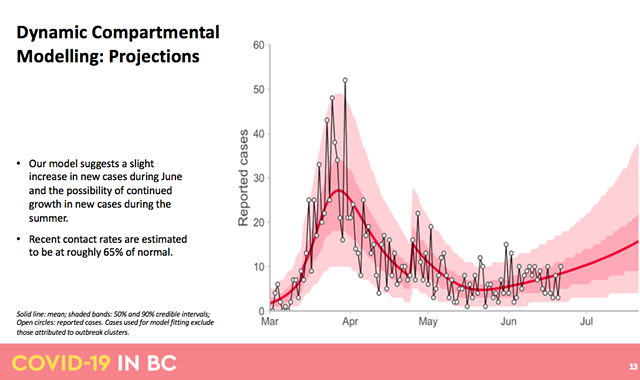B.C. IS APPROACHING the threshold for renewed growth in COVID-19 cases as the economy reopens and residents increase their contacts with fellow British Columbians.
Epidemiological modelling released Tuesday, June 23, reveals contacts between British Columbians are at 65 per cent of normal rates.
The higher the percentage, the greater probability of COVID-19 spreading as people return to work, shop at stores, dine at restaurants or visit friends and family.
The West Coast has seen a slight increase in contacts, but the data does not indicate a substantial increase in infections or hospitalizations.
Rather, this suggests that British Columbians have been increasing their contacts with others in a safe way, such as donning personal protective equipment, standing behind barriers and avoiding large gatherings in small spaces.
Health officials do not believe the province is bound for rapidly explosive growth based on current modelling.
B.C.'s Provincial Health Officer Dr. Bonnie Henry likened it to a slight increase of a dimmer switch on a light as opposed to a rapid spike.
"Today's modelling shows us that in British Columbia the measures we have in place to protect ourselves and each other from COVID-19, combined with the slow, gradual transition in Phase 2, is working," said Henry in a release.
"We have eased our restrictions in a way that has allowed us to increase our social interactions to around 65 per cent, while keeping our new cases of COVID-19 low.
"Looking ahead, until we have an effective treatment or vaccine, the rules for safe social interactions must continue to be maintained as part of our everyday activities to stay at this manageable level.
"The modelling tells us that if we go too far, we risk a rapid rebound in B.C., something many others are now experiencing."
The government is urging British Columbians to abide by measures such as physical distancing, self-isolation for those who feel ill and practising proper hygiene.
The modelling also shows the province's case rate per 1 million people is among the lowest in Canada, on par with Newfoundland and Labrador and dramatically less than provinces such as Ontario and Quebec.
At the same time, mobility data shows British Columbians are boosting their activity levels with more time spent in parks and less time inside their homes.
Provincial data shows mobility might be increasing for many in the province as people return to class and work but remain below seasonal norms in comparison with 2019 levels.
Meantime, the B.C. Centre for Disease Control has been working with other jurisdictions to test wastewater for COVID-19, as the coronavirus has demonstrated the capacity to be shed in feces.
So far no samples of COVID-19 has been detected in any collected wastewater samples over the last five weeks, indicating a low level of community transmission.
But the research could be used as an early detection tool for communities.
The province also revealed Tuesday 13 new cases of COVID-19 have been confirmed over the past 24 hours for a total of 2,835 cases.
One additional death was also reported.
Sixteen people are currently in hospital as a result of COVID-19.




